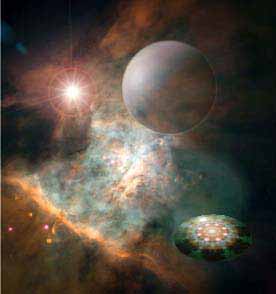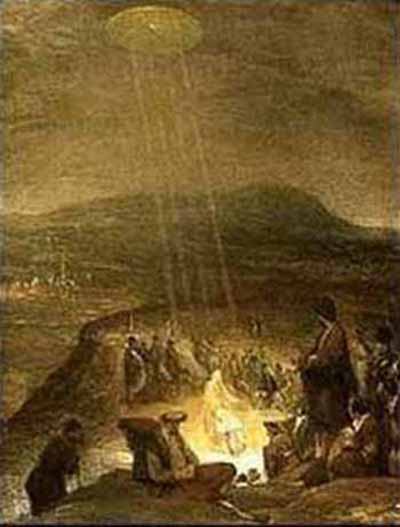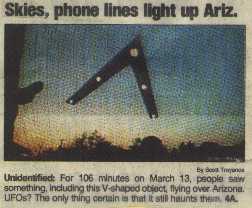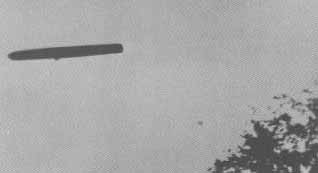

In 2012 there is an increase in UFO sightings around the world - so much so that people think nothing about seeing lights in the sky or objects that fit the descriptions of UFOs from the past.
UFOs are believed to be either those created by governments using reverse engineering, others flown by aliens, or simply drones. Most people agree that UFO sightings are a global event - ships seen both in the air and emerging from the water. Everyone believes that governments cover up evidence of UFO visitations while conspiracy theorist speculate about who did what and why.
Sightings generally are still not conclusive - merely lights in the sky at night or objects in the distance but nothing to corroborate who is flying what, as if we are not suppose to know at this time.
UFOs are seen before and after large natural disasters leaving one to speculate that aliens are preventing the planet from blowing up or ... causing the disasters. They are also seen near nuclear reactors and active volcanoes.
Everyone has a theory about UFOs as if waiting for something major to happen that explains not only the extraterrestrial-human connection, but who created us and where it is all going. Many believe humans were created as part of evolving biogenetic experiments that continue to this day.
A UFO, or unidentified flying object, is any real or apparent flying object which remains unidentified after investigation.
UFO researcher J. Allen Hynek described a UFO as "the reported perception of an object or light seen in the sky or upon the land the appearance, trajectory, and general dynamic and luminescent behavior of which do not suggest a logical, conventional explanation and which is not only mystifying to the original percipients but remains unidentified after close scrutiny of all available evidence by persons who are technically capable of making a common sense identification, if one is possible."
Some people believe UFOs are extraterrestrial spacecraft, but most scientists and academics say there is no compelling evidence to support such a conclusion. Such skeptical attitudes adhere to a standard of research attributed to Carl Sagan that "extraordinary claims require extraordinary evidence". As a result, claims that UFOs are extraterrestrial spacecraft are generally dismissed through lack of evidence. Because of such beliefs, in pop culture, UFO is commonly used to refer to any hypothetical alien spacecraft, even ones that would be identified as such, despite the etymology.

UFO's in Art History
During the reign of the Pharaoh Thutmose III around 1450 BC, there is a description of multiple "circles of fire" brighter than the sun and about 5 meters in size that appeared over multiple days. They finally disappeared after ascending higher in the sky.
The army of Alexander the Great in 329 BC, as they were crossing a river into India, saw "two silver shields" in the sky that dove repeatedly on their military columns causing panic. In 322 BC when Alexander was besieging Tyre in Phoenicia, another "flying shield" moving in triangular formation with smaller "shields" approached. Supposedly the larger object shot beams of light at the city shattering its walls and other defenses. Alexander's army quickly took advantage of the situation and seized the city. The objects then departed.
The Roman author Julius Obsequens writes that in 99 BC, "in Tarquinia towards sunset, a round object, like a globe, a round or circular shield, took its path in the sky from west to east."
On September 24, 1235, General Yoritsume and his army observed unidentified globes of light flying in erratic patterns in the night sky near Kyoto, Japan. The Generals advises told him not to worry - it was merely the wind causing the stars to sway.
On April 14, 1561 the skies over Nuremberg, Germany were reportedly filled with a multitude of objects seemingly engaged in an aerial battle. Small spheres and discs were said to emerge from large cylinders.These sightings were usually treated as supernatural portents, angels, and other religious omens. Some contemporary investigators believe them to be the ancient equivalent of modern UFO reports.
These sightings were usually treated as supernatural portents, angels (aliens), and other religious omens. Some contemporary investigators believe them to be the ancient equivalent of modern UFO reports.
Before the terms "flying saucers" and "UFO" were coined, there were a number of reports of strange, unidentified aerial phenomena. These reports date from the mid-nineteenth to early twentieth century. They include:
On January 25, 1878, The Denison Daily News wrote that local farmer John Martin had reported seeing a large, dark, circular flying object resembling a balloon flying "at wonderful speed."
On November 17, 1882, astronomer E. W. Maunder of the Greenwich Royal Observatory described in the Observatory Reports "a strange celestial visitor" that was "disc-shaped," "torpedo-shaped," or "spindle-shaped." It was said to be very different in characteristics from a meteor fireball. Years later, Maunder wrote it looked exactly like the new Zeppelin dirigibles. The strange object was also seen by several other European astronomers.
On February 28, 1904, there was a sighting by three crew members on the U.S.S. Supply 300 miles west of San Francisco, reported by Lt. Frank Schofield, later to become Commander-in-Chief of the Pacific Fleet. Schofield wrote of three bright red egg-shaped and circular objects flying in echelon formation that approached beneath the cloud layer, then changed course and "soared" above the clouds, departing directly away from the earth after 2 to 3 minutes. The largest had an apparent size of about six suns.
The so-called Fatima incident or "The Miracle of the Sun," witnessed by tens of thousands in Fatima, Portugal on October 13, 1917, is believed by some researchers to actually be a UFO event.
In both the European and Japanese aerial theatres during World War II, Foo-fighters (balls of light and other shapes that followed aircraft) were reported by both Allied and Axis pilots.
On February 25, 1942, an unidentified craft was detected over the California region. The craft stayed aloft despite taking at least 20 minutes worth of flak from ground batteries. The incident later became known as the Battle of Los Angeles, or the West coast air raid.
In 1946, there were over 2000 reports of unidentified aircraft in the Scandinavian nations, along with isolated reports from France, Portugal, Italy and Greece, then referred to as "Russian hail," and later as "ghost rockets," because it was thought that these mysterious objects were Russian tests of captured German V1 or V2 rockets. This was subsequently shown not to be the case, and the phenomenon remains unexplained. Over 200 were tracked on radar and deemed to be "real physical objects" by the Swedish military. A significant fraction of the remainder were thought to be misperceptions of natural phenomena, such as meteors.
The post World War II UFO phase in the United States began with a reported sighting by American businessman Kenneth Arnold on June 24, 1947 while flying his private plane near Mount Rainier, Washington. He reported seeing nine brilliantly bright objects flying across the face of Rainier towards nearby Mount Adams at "an incredible speed", which he calculated at at least 1200 miles an hour by timing their travel between Rainier and Adams. His sighting subsequently received significant media and public attention. Arnold would later say they "flew like a saucer would if you skipped it across the water" and also said they were "flat like a pie pan", "shaped like saucers," and "half-moon shaped, oval in front and convex in the rear. ...they looked like a big flat disk." (One, however, he would describe later as being almost crescent-shaped.) Arnold's reported descriptions caught the media's and the public's fancy and gave rise to the terms flying saucer and flying disk.
Arnold's sighting was followed in the next few weeks by several thousand other reported sightings, mostly in the U.S., but in other countries as well.
Perhaps the most significant of these was a United Airlines crew sighting of nine more disc-like objects over Idaho on the evening of July 4. This sighting was even more widely reported than Arnold's and lent considerable credence to Arnold's report. For the next few days most American newspapers were filled with front-page stories of the new "flying saucers" or "flying discs."
Starting with official debunkery that began the night of July 8 with the Roswell UFO incident, reports rapidly tapered off, ending the first big U.S. UFO wave.
Starting July 9, Army Air Force intelligence, in cooperation with the FBI, secretly began a formal investigation into the best sightings, which included Arnold's and the United crew. The FBI was told that intelligence was using "all of its scientists" to determine whether or not "such a phenomenon could, in fact, occur."
Furthermore, the research was "being conducted with the thought that the flying objects might be a celestial phenomenon," or that "they might be a foreign body mechanically devised and controlled." Three weeks later they concluded that, "This 'flying saucer' situation is not all imaginary or seeing too much in some natural phenomenon. Something is really flying around."
A further review by the intelligence and technical divisions of the Air Materiel Command at Wright Field reached the same conclusion, that "the phenomenon is something real and not visionary or fictitious," that there were objects in the shape of a disc, metallic in appearance, and as big as man-made aircraft. They were characterized by "extreme rates of climb [and] maneuverability," general lack of noise, absence of trail, occasional formation flying, and "evasive" behavior "when sighted or contacted by friendly aircraft and radar," suggesting either manual, automatic, or remote control.
It was thus recommended in late September 1947 that an official Air Force investigation be set up to investigate the phenomenon. This led to the creation of the Air Force's Project Sign at the end of 1947, which became Project Grudge at the end of 1948, and then Project Blue Book in 1952. Blue Book closed down in 1970, ending the official Air Force UFO investigations.
Use of "UFO" instead of "flying saucer" was first suggested in 1952 by Capt. Edward J. Ruppelt, the first director of Project Blue Book, who felt that "flying saucer" did not reflect the diversity of the sightings. Ruppelt suggested that "UFO" should be pronounced as a word - "you-foe". However it is generally pronounced by forming each letter: "U.F.O." His term was quickly adopted by the Air Force, which also briefly used "UFOB" circa 1954.
Ruppelt recounted his experiences with Project Blue Book in his memoir, The Report on Unidentified Flying Objects (1956), also the first book to use the term.
Air Force Regulation 200-2, issued in 1954, defined an Unidentified Flying Object (UFOB) as "any airborne object which by performance, aerodynamic characteristics, or unusual features, does not conform to any presently known aircraft or missile type, or which cannot be positively identified as a familiar object."
The regulation also said UFOBs were to be investigated as a "possible threat to the security of the United States" and "to determine technical aspects involved." Furthermore, Air Force personnel were directed not to discuss unexplained cases with the press.
Beginning in the 1950s, UFO-related spiritual sects, sometimes referred to as contactee cults, began to appear. Most often the members of these sects rallied around a central individual, who claimed to either have made personal contact with space-beings, or claimed to be in telepathic contact with them.
Prominent among such individuals was George Adamski, who claimed to have met a tall, blond-haired Venusian named "Orthon," who came to warn us about the dangers of nuclear proliferation. Adamski was widely dismissed, but an Adamski Foundation still exists, publishing and selling Adamski's writings.
At least two of these sects developed a substantial number of adherents, most notably The Aetherius Society, founded by British mystic George King in 1956, and the Unarius Foundation, established by "Ernest L." and Ruth Norman in 1954.
A standard theme of the alleged messages from outer-space beings to these cults was a warning about the dangers of nuclear proliferation. More recent groups organized around an extraterrestrial theme include Ummo, Heaven's Gate, Ra‘l, and the Ashtar Command. Many of the early UFO sects, as well as later ones, share a tendency to incorporate ideas from both Christianity and various eastern religions, "hybridizing" these with ideas pertaining to extraterrestrials and their benevolent concern with the people of Earth.
The notion of contactee cults gained a new twist during the 1980s, primarily in the USA, with the publication of books by Whitley Strieber (beginning with Communion) and Jacques Vallee (Passport to Magonia). Strieber, a horror writer, felt that aliens were harassing him and were responsible for "missing time" during which he was subjected to strange experiments by 'grey aliens'. This newer, darker model can be seen in the subsequent wave of "alien abduction" literature, and in the background mythos of The X Files and many other TV series.
However, even in the alien abduction literature, motives of the aliens run the gamut from hostile to benevolent. For example, researcher David Jacobs believes we are undergoing a form of stealth invasion through genetic assimilation.
The theme of genetic manipulation (though not necessarily an invasion) is also strongly reflected in the writings of Budd Hopkins.
The late Harvard psychiatrist John Mack (1929-2004) believed that the aliens' ethical bearing was to take a role as "tough-love" gurus trying to impart wisdom. James Harder says abductees predominantly report positive interactions with aliens, most of whom have benevolent intentions and express concern about human survival.
An interesting 1970s-era development was a renewal and broadening of ideas associating UFOs with supernatural or preternatural subjects such as occultism, cryptozoology, and parapsychology. Some 1950s contactee cultists had incorporated various religious and occult ideas into their beliefs about UFOs, but in the 1970s this was repeated on a considerably larger scale.
Many participants in the New Age movement came to believe in alien contact, both through mediumistic channeling and through literal, physical contact. A prominent spokesperson for this trend was and is actress Shirley MacLaine, especially in her book and miniseries, Out On a Limb. The 1970s saw the publication of many New Age books in which ideas about UFOs and extraterrestrials figured prominently.
Another key development in 1970s UFO folklore came with the publication of Erich von Daniken's book Chariots of the Gods. The book argued that aliens have been visiting Earth for thousands of years, which he purported to explain UFO-like images from various archeological sources as well as unsolved mysteries. Such ideas were not exactly new.
For example, earlier in his career, astronomer Carl Sagan in Intelligent Life in the Universe (1966) had similarly argued that aliens could have been visiting the Earth sporadically for millions of years.
"Ancient astronauts" proposals inspired numerous imitators, sequels, and fictional adaptations, including one book (Barry Downing's The Bible and Flying Saucers) which interprets miraculous aerial phenomena in the Bible as records of alien contact. Many of these interpretations posit that aliens have been guiding human evolution, an idea taken up earlier by the novel and film '2001: A Space Odyssey.'
UFOs constitute a widespread international cultural phenomenon of the last half-century.
Folklorist Thomas E. Bullard writes, "UFOs have invaded modern consciousness in overwhelming force, and endless streams of books, magazine articles, tabloid covers, movies, TV shows, cartoons, advertisements, greeting cards, toys, T-shirts, even alien-head salt and pepper shakers, attest to the popularity of this phenomenon.
Gallup polls rank UFOs near the top of lists for subjects of widespread recognition.
In 1973, a survey found that 95 percent of the public reported having heard of UFOs, whereas only 92 percent had heard of President Gerald Ford in a 1977 poll taken just nine months after he left the White House.
A 1996 Gallup poll reported that 71% of the United States' population believed that the government was covering up information regarding UFOs.
A 2002 Roper poll for the Sci Fi channel found similar results, but with more people believing UFOs were extraterrestrial craft. In that latest poll, 56% thought UFOs were real craft and 48% that aliens had visited the Earth. Again, about 70% felt the government was not sharing everything it knew about UFOs or extraterrestrial life.
Ufology is a neologism coined to describe the collective efforts of investigators who study UFO reports and associated evidence. While ufology does not represent an academic research program, UFOs have been subject to various investigations over the years, varying widely in scope and scientific rigor.
Governments or independent academics in the United States, Canada, the United Kingdom, France, Belgium, Sweden, Brazil, Mexico, Spain, and the Soviet Union are known to have investigated UFO reports at various times. Among the best-known major studies was:
The Ghost rockets study (1946-1947) by the Swedish and Greek militaries
Project Blue Book, probably the best known study, previously Project Sign and Project Grudge, conducted by the United States Air Force from 1947 until 1970.
Green Fireballs Project Twinkle investigation (1948-1951), by the USAF
Robertson Panel (1953), organized by the CIA
Brookings Report (1960), commissioned by NASA
Condon Committee (1966-1968), commissioned by the USAF>French GEPAN/SEPRA studies (1977-2004), by the French government, run by the French space agency CNES
French COMETA (1996-1999), a private study by high French military officers and aerospace experts, many associated with SEPRA
No national government has ever publicly suggested that UFOs represent any form of alien intelligence. However, a few internal, classified government studies have suggested this or had individuals associated with them who have held such opinions. Examples are the 1948 Estimate of the Situation by Project Sign personnel and the heads of the French GEPAN/SEPRA studies, who have publicly supported the Extraterrestrial Hypothesis.
Large triangular "craft" or triangular light pattern

Cigar-shaped "craft" with lighted windows
Saucer, toy-top, or disk-shaped "craft" without visible or audible propulsion. (day and night)
Rapidly-moving lights or lights with apparent ability to rapidly change direction
Chevrons, cigar shape, equilateral triangles, spheres, domes, diamonds, shapeless black masses, eggs, and cylinders.

Besides visual sightings, cases sometimes have alleged associated physical evidence. Some of these cases have been shown to be deliberate hoaxes. Others have been shown to be explainable as natural or manmade phenomena. The remaining fraction have been labeled unidentified or unexplainable. Analyses of such cases have results that are usually ambiguous or inconclusive.
A list of various purported physical evidence cases from government and private studies includes:
Radar contact and tracking, sometimes from multiple sites. These cases often involve trained military personnel and control tower operators, simultaneous visual sightings, and aircraft intercepts. One such recent example were the mass sightings of large, silent, low-flying black triangles in 1989 and 1990 over Belgium, tracked by multiple NATO radar and jet interceptors, and investigated by Belgium's military (included photographic evidence). Another famous case from 1986 was the JAL 1628 case over Alaska investigated by the FAA.
Photograpic evidence, including still photos, movie film, and video
Landing physical trace evidence, including ground impressions, burned and/or desiccated soil, burned and broken foliage, magnetic anomalies, increased radiation levels, and metallic traces.
Physiological effects have been reported including skin burns and symptoms resembling radiation poisoning.
Animal/Cattle Mutilation cases, that some feel are also part of the UFO phenomenon. Such cases can and have been analyzed using forensic science techniques.
Biological effects on plants such as increased or decreased growth, germination effects on seeds, and elongated and blown-out stem nodes (usually associated with physical trace cases or crop circles)
Electromagnetic interference (EM) effects, including stalled cars, power black-outs, radio/TV interference, magnetic compass deflections, and aircraft navigation, communication, and engine disruption.
Remote nuclear radiation detection, some noted in FBI and CIA documents occurring over government nuclear installations at Los Alamos National Laboratory and Oak Ridge National Laboratory in 1950, also reported by Project Blue Book director Ed Ruppelt in his book.
Hard physical evidence cases, such as 1957, Ubatuba, Brazil, magnesium fragments analyzed by the Brazilian government and in the Condon Report and by others. The 1964 Socorro/Lonnie Zamora incident also left metal traces, analyzed by NASA.
Misc. electromagnetic phenomena, such as microwaves detected in the well-known 1957 RB-47 surveillance aircraft case, which was also a visual and radar case; polarization rings claimed to be observed around a UFO by a scientist, explained by James Harder as intense magnetic fields from the UFO causing the Faraday effect.
These various reported physical evidence cases have been studied by various scientist and engineers, both privately and in official governmental studies (such as Project Blue Book, the Condon Committee, and the French GEPAN/SEPRA). A comprehensive scientific review of physical evidence cases was carried out by the 1998 Sturrock UFO panel.
Statistics compiled by U.S. Air Force studies found that the strong preponderance of identified sightings were due to misidentifications, with hoaxes and psychological aberrations accounting for only a few percent of all cases.Nevertheless, many cases remained unexplained.
An Air Force study by Battelle Memorial Institute scientists in 1954 of 3200 USAF cases found 22% were unknowns, and with the best cases, 35% remained unsolved. Similarly about 30% of the UFO cases studied by the 1969 USAF Condon Committee were deemed unsolved when reviewed by the American Institute of Aeronautics and Astronautics (AIAA).
The official French government UFO scientific study (GEPAN/SEPRA) from 1976 to 2004 listed about 14% of 5800 cases as inexplicable.
Despite the unexplained cases, many skeptics of the phenomenon in the mainstream scientific community, such as astronomer Carl Sagan, have continued to say that no UFO sighting requires extraordinary explanations.
Very little in the way of solid physical evidence has been reported, and because UFO sightings are transitory events, there is no opportunity for the repeat testing called for by scientific method. Ockham's razor is invoked by such skeptics since it is considered less incredible for the explanations to be the result of scientifically verified phenomena rather than resulting from novel mechanisms (e.g. the extraterrestrial hypothesis).
To account for hardcore unsolved cases, a number of explanations have been proposed by both proponents and skeptics. Among proponents, some of the more common explanations for UFOs are:
The Extraterrestrial Visitation Hypothesis (ETH) (most popular)
The Interdimensional Hypothesis
The Paranormal/Occult Hypothesis
The hypothesis that they are time machines or vehicles built in a future time.
Similarly, skeptics usually propose the following explanations:
The Psychological-Social Hypothesis
The man-made craft hypothesis
The unknown natural phenomena hypothesis, e.g. ball lightning, sprites
The Earthlights/Tectonic Strain hypothesis
Usually a combination of explanations is cited to explain all cases, and even proponents will sometimes invoke skeptical explanations, such as man-made craft, to possibly account for some unsolved cases.
The study of UFO claims over the years has led to valuable discoveries about atmospheric phenomena and psychology. In psychology, the study of UFO sightings has revealed information on misinterpretation, perceptual illusions, hallucination and fantasy-prone personality, which may explain why some people are willing to believe hoaxers such as George Adamski. Many have questioned the reliability of hypnosis in UFO abduction cases.
Carl G. Jung, the Swiss analytical psychologist, published a book about UFOs in 1957 (Flying Saucers: A Modern Myth of Things Seen in the Skies). In it, he approached them, without addressing the question of their existence, as objects of the collective unconscious and modern archetypes.
UFO Conspiracy Theories Wikipedia
UFOS Wikipedia
List of Major UFO Sightings Wikipedia
List of UFO Researchers Wikipedia
List of Major UFO Film and Television Shows Wikipedia